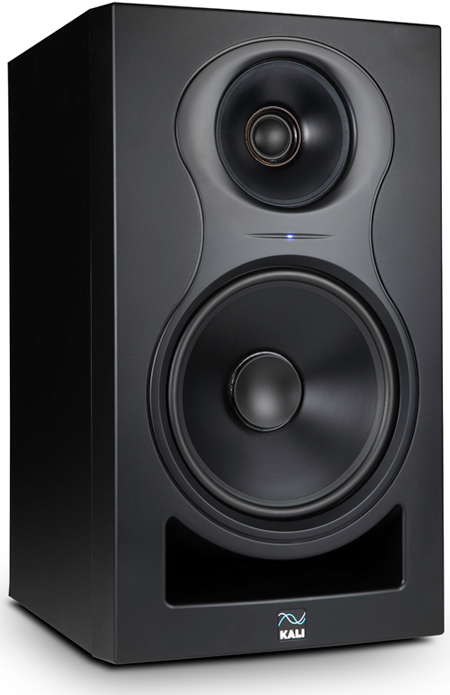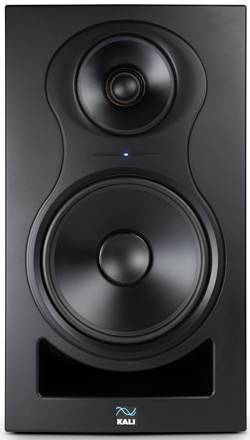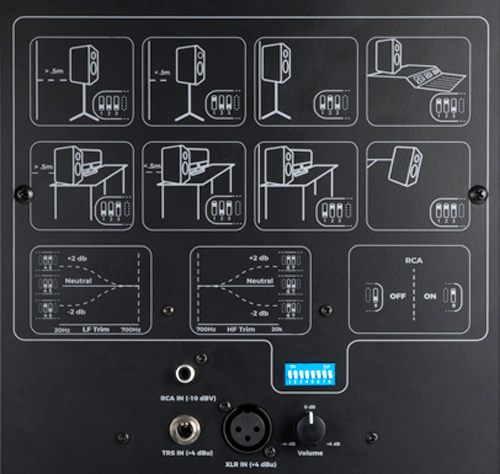
Barry's Mix Magazine Equipment And Software Reviews
Barry's Massive Discography And Engineering Career
Barry's Music Connection Magazine Reviews
Barry's Resolution Magazine Reviews
Kali Audio IN-8 Three-Way Coincident Studio Monitor
By Barry Rudolph
 | Kali Audio IN-8 Three-Way Coincident Studio Monitor |
The latest entry in the Kali Audio line of affordable, powered studio monitors is the IN-8 three-way speaker, expanding on the Kali two-way LP-6 and LP-8 powered models. The IN-8 has an 8-inch woofer, a single 4-inch midrange driver and a 1-inch tweeter, making use of the same woofer, tweeter and front port shape/design as the Kali LP-8 monitor. However, the two monitors differ significantly with the LP-8's large, oblate waveguide surrounding its tweeter replaced by the IN-8's coaxial or coincident, midrange/tweeter transducer and integrated waveguide.
Coaxial (Coincident) Speakers
In the past, coaxial speaker designs like the famous Altec Lansing 604E, placed a midrange/treble horn driver in the center of the woofer. Another popular method used in compact car stereo speakers is to mount the tweeter on a perforated plate in front of the woofer. In both examples, the midrange/tweeter assembly is not physically attached to the woofer and is for the most part, (acoustically) transparent to the woofer's bass frequencies.
Drivers with coaxial designs share the same acoustic center and produce a single, coherent acoustic point source. When monitors with physically separated midrange and tweeter drivers (like most two-ways) reproduce the same frequencies, two or more wave lobes are created that will interfere with each other, i.e. add or subtract from each other. Acoustic off-axis "lobing" is most problematic at or near the crossover frequency between the two drivers.
 | Kali Audio IN-8 Studio Monitor |
With the Kali Audio IN-8, the woofer is mounted in the cabinet just below the midrange/tweeter transducer--a concentric driver that has a dome tweeter placed where normally the dust cap would fit. There is a small plastic trim ring outside the tweeter's edge and then a small air gap physically separating it from the midrange cone itself. There is no inner suspension between the midrange cone and the tweeter. The circular driver midrange cone acts as the waveguide for its coaxially mounted tweeter.
But using a vibrating midrange cone for the tweeter's waveguide will result in tweeter/midrange inter-modulation distortion (IMD) if the design is poor. To prevent IMD, the total amount of peak excursion allowable for the midrange cone has to be under 1-mm. Excursion is constrained by the driver's electro-mechanical limits, including damping, maintaining a predictable SPL output and, most importantly, the chosen crosssover frequency. Back and forth cone travel is a function of frequency with more excursion at lower frequencies.
Using a second-order filter, the crossover frequency is 330 Hz between the woofer and the midrange/tweeter driver. Furthermore, the woofer and midrange/tweeter drivers are mounted close together in the cabinet within a quarter wavelength of each other (quarter wavelength of 330 Hz is 26-cm), so the two effectively act together to produce a single point source.
What's Inside?
The IN-8 monitor cabinet is made from MDF (medium density fiberboard) and uses three separate Class-D power amplifiers, with 40-watts for the tweeter, (the midrange-to-tweeter crossover filter uses a fourth-order at 3,000Hz) 40-watts for the midrange and 60-watts powers the woofer. All three amplifiers have protective peak limiters to guard against accidents. The tweeter has a 1-inch textile dome while the midrange uses a poly-coated paper cone.
As compared to Kali Audio's LP-8, the IN-8 is taller at 17.7-inches, but retains the same footprint with a depth of 11-inches and a width at 10-inches. The IN-8 also weighs a bit more at 10.4-Kg.
The IN-8's frequency range (+/-3dB) is specified at 45Hz to 21kHz and max SPL is 114dB at 1-meter. The IN-8 measures continuous 85dB SPL with 20dB dynamic headroom at 2.8-meters away.
Rear panel connections have both unbalanced RCA, balanced XLR and TRS input jacks, standard world IEC/power on/off switch connector, and a +/- 6dB volume control knob with center-detent. There are the same eight DIP-switches as on the LP Series. Switches 1 thru 3 offer eight different boundary curves for low frequency roll-off filters to compensate for where you place the monitor in your room. Switches 4 thru 7 are for +/-2db low and high frequency shelving filters with 0.7 dB/octave from 800Hz down to 100Hz (LF) and from 1.25kHz to 10kHz (HF). The switch 8 turns the RCA input on/off.
The Kali Audio IN-8 also conforms to the new EU regulations regarding power consumption, standby and off modes. The monitor uses 20-watts while in use and 0.5-watts in standby/sleep mode. When no audio is present on the input of the monitor for twenty minutes (green LED), it will go into sleep mode (orange LED). It takes about 3-seconds of audio input to wake the monitors from sleep mode.
What Do They Sound Like?
 | Kali Audio IN-8 Rear Panel |
Because its small size, my mix room (2.9-meters wide) has to be on the dry side (non-reflective) but it's acoustically treated with bass trapping, a combination of diffusion and absorption for the ceiling cloud, and no reflections coming from the left and right side walls on either side of the IN-8s.
For my first tests, I used the AES/EBU digital input on my Cranesong Avocet IIa Monitor Controller to play mastered CDs I know well since I had a hand in engineering and/or mixing them.
Resetting My Expectations
I've never had monitors with concentric drivers in my room before and I was immediately impressed. To be certain for this review, I rechecked everything, established the IN-8's symmetrical setup, and measured and calibrated the output from the Avocet IIa.
I'm still getting use to these new main monitors but I found the stereo imaging and center sound stage locked, consistent and solid. The stereo field is wide--it sounds wider than the actual physical distance between monitors! The center image also does not move as I move about the listening position. I got a full and natural sound without the overkilling and beaming of high frequencies or a hyped bass. I found it very easy to hear deep into these mixes; low level, subtle details such as reverb tails and other effects were heard exactly as intended.
Mixing On The Kali IN-8s
I pulled up a Pro Tools session to mix, a song I had not heard in a while to see how mixing goes using the IN-8s. I wanted to do a fresh mix to hear how it "translated" to my various playback devices I use for checking mixes: Avantone Pro CLA-10s, IK Multimedia iLoud MTMs, iTunes™, iPhone™, headphones, in-ears, and in L+R mono on cheap speakers.
While mixing, I was amazed how well the IN-8s tracked musical dynamics with open and good reproduction of both transients and low frequency EDM-style "pumps." The recorded dynamics from kick drum punches, snare drum accents, and bass guitar "pops" are heard accurately with some of the unprocessed, natural transients hitting too hard or not hard enough.
I started with the default DIP-switch positions: all down or flat but that would soon change. In my room, the monitors are 0.45-meters from the wall behind them and 0.6-meters from the walls on either side. I found the IN-8s very slightly bass heavy and bright for me in this room. I changed to the "up" position switches 1 (as recommended for speaker stand placement less than 0.5-meters from the rear wall) and also switch 6 to roll-off high frequencies. The HF and LF trims are the same as the LP-6 and LP-8 models; +/-2dB tilt EQs centered at 1kHz.
I started mixing a soulful R&B tune with very percussive drums and spikey electric guitars. While getting pan positioning and basic levels, EQs, and compressors set, I would go back and forth between the IN-8s and a couple of pairs of different headphones. I could hear and set pan positioning and EQ just as easily as I do on headphones.
The mix's vocal production was massive, with many tracks of singers panned about the stereo field. The final mix level of the individual harmony parts was easy to attain and that balance held up on the alternate small speaker check later on.
I also noticed that the IN-8s were a less fatiguing than the two-way monitors they replaced. Moving back in my mix room on the couch (nearly 3-meters away) where a lot of my clients like sit and listen, the sound was more even than before and that is good thing!
I finished the mix and checked it on all my usual listening touchstones, and I had no surprises. I'm recommending the IN-8s as an excellent yet inexpensive studio monitor for small mixing spaces. Immediately you'll have crystal clear stereo imaging along with a truthful and accurate representation of what you have recorded and mixed.
|
|
|
|
|
|